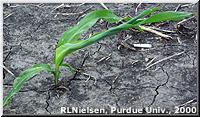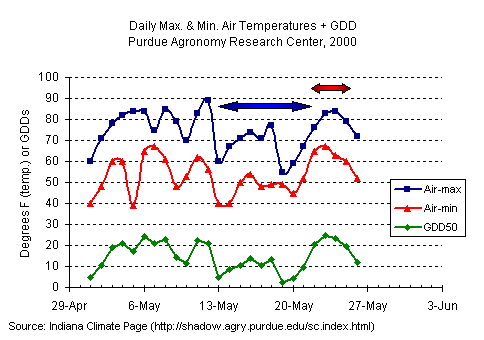
![]() hilst walking corn
fields today (like every good corn grower should be doing regularly early in
the season, I might add!), I noticed something that I had not seen just a few
days ago. Scattered plants throughout the field were exhibiting unusual twisted
growth. The whorls of the affected plants were tightly twisted, often bent over
severely, and not unfurling on a timely basis.
hilst walking corn
fields today (like every good corn grower should be doing regularly early in
the season, I might add!), I noticed something that I had not seen just a few
days ago. Scattered plants throughout the field were exhibiting unusual twisted
growth. The whorls of the affected plants were tightly twisted, often bent over
severely, and not unfurling on a timely basis.
One’s natural instincts would blame the twisted growth on herbicide injury, especially those characterized by the cell growth inhibitor mode of action. Where such herbicides are applied pre-plant or pre-emergence, shoot uptake of the herbicide by the emerging seedling can result in twisted growth. But, in some cases, the cause is something entirely different.
The problem can be related to periods of slow corn growth (typically, cool growing conditions) followed by a sharp transition to periods of rapid corn growth (typically, warm weather plus ample moisture). Such a transition occurred less than seven days ago (see chart below).
Daily maximum temperatures were less than 80F during the ten-day period 13-22 May with five of the ten days' daily maximum only in the 60's and 50's. During one 24-hour period, the daily maximum was only 55F and the daily minimum was 45F. Seven of the ten days' low temperatures were in the 40's or lower. This cool period was followed by a rapid warmup to daily maximums in the low to mid-80's, coupled with a very strong westerly wind on the warmest day. The combination of slow and fast growing conditions was also exemplified by the range of daily GDD accumulations during the past two weeks.

Certain hybrids react to such a change in growing conditions by basically going 'bonkers'. The upper whorls of the plants don't unfurl properly. Younger leaves deeper in the whorl continue to grow rapidly, but are unable to emerge from the unfurled upper leaves. The now tightly twisted whorl then bends and kinks from the pressure exerted from the younger leaves' continued growth. The growth stage where I've observed this phenomenon in past years was around four to six visible leaf collars (about knee-high).
At the peak of the problem, the appearance of these plants is indeed unsettling and one would think that the whorls would never unroll properly. Given another week, though, the majority of the affected plants do unroll and continue to grow normally. Yield effects from the period of twisted growth will be minimal, if any.
If you didn't notice the twisted growth to begin with, you may notice the appearance of 'yellow tops' across the field after the whorls unroll. The younger leaves that had been trapped inside the twisted upper leaves emerge fairly yellow due to the fact that they had been shaded for quite some time.
In addition to being fairly yellow, the leaves will exhibit a crinkly surface caused by their restricted expansion inside the twisted whorl. Another day or two will green these up and the problem will no longer be visible.